Potty training a puppy can often feel like an overwhelming endeavor, full of excitement, anticipation, and yes, a few messes along the way. As new pet parents dive into this transformative phase, the journey to a fully house-trained furry friend begins. Whether you’re welcoming a tiny ball of fluff for the first time or adding to your growing pack, understanding the best strategies can set you up for success. In this article, we’ll explore effective methods that not only teach your puppy where to go but also strengthen the bond between you and your four-legged companion. With patience, consistency, and a little bit of know-how, you’ll soon discover that potty training can be a rewarding experience, paving the way for a harmonious life together. Let’s embark on this adventure, one paw at a time!
Table of Contents
- Understanding Your Puppy’s Bladder: Signs and Timing for Effective Training
- Choosing the Right Potty Training Method: Comparing Techniques and Their Benefits
- Creating a Consistent Routine: The Key to Establishing Good Bathroom Habits
- Positive Reinforcement Strategies: Encouraging Your Puppy with Praise and Rewards
- Q&A
- Insights and Conclusions
Understanding Your Puppy’s Bladder: Signs and Timing for Effective Training
Potty training your puppy effectively relies significantly on understanding the physiological signals associated with their developing bladder. Puppies generally exhibit certain behaviors when they need to relieve themselves. Common signs include:
- Sniffing around or circling their designated bathroom area
- Whining or whining softly, often indicating discomfort
- Suddenly stopping play or turning away
- Restlessness or pacing, as they search for a spot to go
Timing is essential in this training process. Consistent potty breaks, especially after meals, playtime, or waking up, can help establish a routine. Understanding your puppy’s bladder capacity can also guide you in setting a framework for effective training. Typically, a general rule is:
| Age of Puppy | Approximate Bladder Holding Time |
|---|---|
| 8 weeks | 1 hour |
| 3 months | 3 hours |
| 6 months | 6 hours |
| 1 year | 8 hours |
Based on this information, proactively taking your puppy outside at regular intervals will drastically improve their chances of success and minimize accidents in the home.
Choosing the Right Potty Training Method: Comparing Techniques and Their Benefits
When it comes to potty training your puppy, selecting a method that aligns with both your lifestyle and your puppy’s temperament is crucial. Among the various approaches, some popular techniques include:
- Crate Training: Utilizing a crate to create a den-like environment can help your puppy learn to hold their bladder. This method relies on the natural instinct of canines to avoid soiling their sleeping area.
- Outdoor Training: Regularly taking your puppy outside to designated bathroom spots reinforces the idea that outside is the right place to go, especially after meals and naps.
- P pads or Indoor Potty Systems: If outdoor access is limited, providing an indoor potty solution can be effective. These pads encourage your puppy to relieve themselves in a specific location inside the home.
Each of these techniques offers distinct advantages. For instance, crate training not only assists with potty habits but also fosters a safe space for your dog. On the other hand, outdoor training immerses your puppy in the scents and sounds of nature, making it a richer experience. To help you visualize the differences, consider the following table:
| Method | Benefits |
|---|---|
| Crate Training | Creates a safe den, reinforces bladder control |
| Outdoor Training | Builds a connection with the environment, encourages exploration |
| Indoor Potty Systems | Offers flexibility for apartment living, convenient in bad weather |
Creating a Consistent Routine: The Key to Establishing Good Bathroom Habits
Establishing a reliable schedule is essential for promoting good bathroom habits in your puppy. By determining specific times for toileting—such as after meals, playtime, or naps—you create a predictable routine that helps your furry friend understand when and where it’s appropriate to go. Regular bathroom breaks can greatly reduce accidents indoors, as your puppy learns to associate these moments with the opportunity to relieve themselves. Remember to also stay consistent with verbal cues, such as “go potty,” to reinforce the desired behavior.
To better understand your puppy’s patterns and needs, consider maintaining a simple record of their bathroom habits. This can help you identify trends and adjust their schedule accordingly. You might find it useful to use a table like the one below:
| Time of Day | Activity | Bathroom Break |
|---|---|---|
| 7:00 AM | Wake Up | Yes |
| 8:00 AM | Breakfast | Yes |
| 12:00 PM | Lunch | Yes |
| 5:00 PM | Dinner | Yes |
| 10:00 PM | Bedtime | Yes |
In addition to timing, ensure that you provide a designated spot for bathroom breaks, whether it’s outside or a puppy pad indoors. By consistently taking your puppy to the same area, they will start to associate that specific location with going potty. Praise and reward them immediately after they succeed, as positive reinforcement plays a significant role in solidifying these good bathroom habits.
Positive Reinforcement Strategies: Encouraging Your Puppy with Praise and Rewards
When training your puppy, a vital component is the use of positive reinforcement. This method relies on encouraging desired behaviors through praise and rewards, which can create a joyful learning environment for your furry friend. Whenever your puppy successfully goes potty outside, immediately offer enthusiastic verbal praise such as “Good job!” or “Well done!” This verbal affirmation reinforces the positive behavior and helps them associate going potty in the right place with being praised. In addition to verbal praise, tangible rewards can play a significant role in the training process.
Consider employing a reward system that incorporates treats or toys as incentives for your puppy. For example, you can create a simple chart to help track progress and rewards. A system like this not only keeps the training organized but also lets your puppy learn the correlation between their actions and positive outcomes. Here’s a brief overview of helpful rewards:
| Reward Type | Description |
|---|---|
| Treats | Small, tasty bites that your puppy loves. |
| Playtime | A fun game or session with their favorite toy. |
| Affection | Giving belly rubs or cuddles can be a powerful reward. |
Combining praise with a structured reward system not only enhances the learning experience but also strengthens the bond between you and your pup as they learn the ropes of potty training. Remember, consistency is key; reward your puppy every time they successfully perform the desired behavior to reinforce it effectively.
Q&A
Q&A: The Best Way to Potty Train a Puppy
Q1: What is the ideal age to start potty training my puppy?
A1: While puppies can begin learning as early as 8 weeks old, the best time to start potty training is when you bring your new furry friend home. Their little bladders may not be able to hold it for long, so starting early sets the stage for success.
Q2: What’s the first step in potty training my puppy?
A2: The first step is establishing a consistent routine. Take your puppy out at the same times every day, such as after waking up, after meals, and before bedtime. This helps them learn when it’s time to go.
Q3: How do I choose the right potty spot for my puppy?
A3: Select a designated area in your yard or nearby that’s quiet, away from distractions. This allows your puppy to focus on what they need to do without getting sidetracked by the sights and sounds of the world around them.
Q4: What should I do when my puppy goes potty outside successfully?
A4: Celebrate! Praise your puppy enthusiastically and offer a treat immediately after they finish. Positive reinforcement helps them associate going potty outside with good things.
Q5: My puppy had an accident in the house. What should I do?
A5: Remain calm. Clean the area thoroughly with an enzymatic cleaner to eliminate the scent, which can encourage repeat accidents. Avoid scolding your puppy, as this can create fear and confusion.
Q6: How long does it typically take to potty train a puppy?
A6: Every puppy is different, but consistency is key. Most puppies become reliably trained within a few weeks to several months, depending on their age, breed, and individual personality.
Q7: Should I use a crate for potty training?
A7: Yes! Crate training can be a useful tool. Puppies instinctively avoid soiling their sleeping area, so a properly sized crate encourages them to hold it until they’re let outside. Just remember to never use the crate as a form of punishment.
Q8: What if my puppy refuses to go potty outside?
A8: Be patient! If your puppy is hesitant, keep them on a leash and give them time to explore the designated area. Sometimes, they may need encouragement or a little extra time to feel comfortable.
Q9: Are there any signs that my puppy needs to go?
A9: Yes! Watch for signs such as sniffing, circling, whining, or heading toward the door. These are all indications that they may need to relieve themselves, and taking them out promptly can prevent accidents.
Q10: Can I use puppy pads, and if so, how?
A10: Puppy pads can be a helpful transitional tool, especially in apartments or during inclement weather. However, be mindful that this may confuse your puppy about where it’s appropriate to go. If you choose to use them, gradually move the pads closer to the door until your puppy associates outdoor potty time with their training.
Q11: What is the biggest mistake to avoid while potty training a puppy?
A11: One of the biggest mistakes is not being consistent. Mixed signals can confuse your puppy; ensure that everyone in your household adheres to the same potty-training routine and expectations to foster success.
By following these guidelines and being patient and consistent, you’ll pave the way for a well-potty-trained puppy in no time! Happy training!
Insights and Conclusions
As you embark on this exciting journey of potty training your puppy, remember that patience, consistency, and positive reinforcement are your best allies. Each paw print on this path marks a step toward a well-trained companion, and while the occasional mishap may occur, they are merely learning opportunities. Celebrate the small victories and cherish the bonds you build during this process, as teaching your pup the art of being house-trained is not just about routine—it’s a stepping stone in nurturing a lifelong friendship. With dedication and love, you will soon find that your home is not only clean but filled with laughter and joy, as you and your furry friend navigate the world together, one paw at a time. Here’s to many successful bathroom breaks and the delightful adventures that lie ahead!

